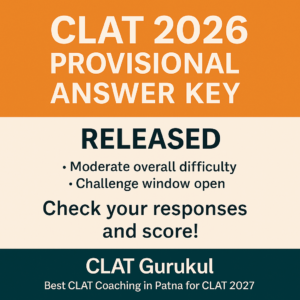
Historical Debate and Contemporary Criticism
Introduction
The reorganisation of Indian states on linguistic lines in 1956 marked a watershed moment in the history of independent India. It was a decision shaped by political agitation, historical demands, and the belief that language, as a marker of identity, could serve as the foundation for administrative convenience and cultural representation.
Recently, however, this foundational decision has come under renewed criticism. Tamil Nadu Governor R. N. Ravi sparked a controversy by questioning the very basis of linguistic states. He argued that such divisions have created large sections of the population who feel like “second-class citizens,” undermining the unity of India.
The debate is not merely academic but highly relevant for law aspirants studying for CLAT Current Affairs 2026, as it touches upon constitutional provisions, federalism, historical state reorganisation, and ongoing tensions between unity and diversity in India. For aspirants preparing with the best online coaching for CLAT or through online coaching for CLAT, this debate offers a valuable case study on constitutional law, political history, and contemporary relevance.
Why in News?
- On July 31, 2025, Tamil Nadu Governor R. N. Ravi criticised the linguistic basis of state reorganisation.
- He claimed that linguistic division has created divisions within populations, reducing one-third of the people in his own state to “second-class citizens.”
- His remarks triggered political debates and revived long-standing questions on whether linguistic reorganisation ensured national unity or deepened divisions.
- This issue is significant as India is witnessing a resurgence of identity-based politics, including demands for smaller states and cultural recognition.
Historical Background
- Before the First Reorganisation (1947–1956)
- At Independence, India inherited historical administrative divisions created by colonial rule.
- On January 26, 1950, India became a Union of States with 28 states divided into four categories:
- Part A States (former Governor’s provinces of British India).
- Part B States (princely states governed by legislatures).
- Part C States (chief commissioners’ provinces).
- Part D States (Andaman and Nicobar Islands).
- Political boundaries were arbitrary, not aligned with linguistic or cultural considerations.
- Demand for Linguistic States
- Movements for linguistic identity grew stronger post-independence.
- The most notable was the Telugu-speaking people’s demand for a separate Andhra state.
- Potti Sriramulu, a Gandhian, went on a hunger strike in 1952, demanding Andhra Pradesh for Telugu speakers. His death after 58 days of fasting triggered widespread protests, compelling the government to act.
- The 1956 Reorganisation
- Prime Minister Nehru initially resisted, fearing balkanisation of India.
- However, mounting pressure led to the creation of the States Reorganisation Commission (SRC) in 1953, chaired by Justice Fazl Ali.
- The SRC recommended state boundaries largely on linguistic lines.
- Based on its report, the States Reorganisation Act, 1956 created 14 states and 6 Union Territories.
- This was hailed as a historic compromise ensuring both administrative convenience and cultural recognition.
Criticism of Linguistic States
Governor R. N. Ravi’s View
- Ravi argued that in his state, Tamil Nadu, linguistic states have caused exclusion:
- People of Telugu, Kannada, Gujarati, Marathi, and Hindi origin coexist, but once language becomes the state’s identity, minorities are reduced to “second-class citizens.”
- He claimed linguistic divisions weakened national unity rather than strengthening it.
Central Government’s Early Concerns
- Even the SRC report noted that linguistic states alone were insufficient and could not be the sole principle of reorganisation.
- The Centre feared that an exclusive focus on language could fragment the nation.
Defense of Linguistic States
- Scholarly Opinion
- Historian Ramachandra Guha in India After Gandhi highlighted that linguistic reorganisation was crucial to preserving democracy.
- He argued that without accommodating linguistic aspirations, separatist movements might have gained traction.
- Unity through Diversity
- Linguistic states allowed citizens to access governance in their mother tongue, empowering them politically.
- Rather than fragmenting India, it reduced alienation and strengthened democratic participation.
- A Success Story
- Despite fears of division, India has remained united since 1956, unlike many newly decolonised states that broke apart.
- Linguistic states thus arguably became a success story of Indian federalism.
Language Not the Only Factor
- Although language was the dominant basis, the SRC also considered:
- Administrative efficiency.
- Economic viability.
- Cultural integration.
- Later reorganisations were based on developmental demands (e.g., Uttarakhand, Jharkhand, Chhattisgarh in 2000).
Maps and Reorganisation
- Map of 1950 (Before Reorganisation):
India divided into Part A, B, C, and D states, often arbitrary. - Map after 1956:
India reorganised into 14 states and 6 Union Territories. - This restructuring remains a defining moment in Indian federalism.
Constitutional Aspects
- Article 1 – India is a “Union of States.”
- Article 3 – Parliament has the power to:
- Create new states.
- Alter boundaries of existing states.
- Change names of states.
(But President’s recommendation is mandatory).
- Federal Structure – Unlike the U.S., Indian federalism allows flexibility in reorganisation, making it unique.
Notes on Peculiar Terms
- Linguistic State – A state formed primarily based on the dominant language of the population.
- Second-Class Citizens – A controversial phrase suggesting people with minority identities in a state feel excluded.
- Potti Sriramulu – Gandhian activist whose fast unto death led to creation of Andhra Pradesh in 1953.
- States Reorganisation Commission (SRC) – Committee formed in 1953 to recommend reorganisation of states.
- States Reorganisation Act, 1956 – Law that reorganised Indian states along linguistic lines.
- Federalism – Distribution of power between central and state governments.
- Union Territories – Regions directly administered by the Centre without full statehood powers.
Broader Implications
- Federal Balance
- Debate shows continuing tension between centralisation and regional autonomy.
- Minority Rights
- Raises the question: Should identity of a state be linked exclusively to language?
- Contemporary Demands
- Newer demands (e.g., Gorkhaland, Vidarbha, Bodoland) highlight ongoing aspirations for smaller states.
- Relevance for CLAT Aspirants
- This issue ties together Constitutional Law, History, and Current Affairs 2026.
- Demonstrates how legal mechanisms manage socio-political demands.
Conclusion
The debate over linguistic reorganisation of states remains one of India’s most consequential constitutional choices. While critics like Governor Ravi argue it fosters divisions, history suggests otherwise: linguistic reorganisation allowed India to survive as a united democracy by accommodating diversity.
For CLAT 2026 aspirants, this controversy is a classic case study linking Articles 1 and 3 of the Constitution, federalism, historical movements, and contemporary debates. At CLAT Gurukul, regarded as the best online coaching for CLAT, we encourage students to study such events deeply because they showcase how legal frameworks balance unity with diversity. Through online coaching for CLAT, aspirants can connect past historical compromises with today’s political debates, making them exam-ready for both the CLAT Current Affairs 2026 section and beyond.
This Blog is Powered by CLAT Gurukul — India’s Leading Law Entrance Prep Platform
At CLAT Gurukul, we believe in empowering future legal minds with the right blend of knowledge, strategy, and mentorship. This blog is a reflection of our commitment to quality content that not only helps aspirants stay updated but also sharpens their conceptual clarity.
Why CLAT Gurukul?
- Personalized Mentorship by Top Legal Educators
- Comprehensive Study Materials & Legal Updates
- Daily Practice Sets, Mocks & Performance Tracking
- Result-Oriented Strategy for CLAT, AILET, and CUET
Whether you’re reading this article to deepen your understanding or to stay ahead in your exam prep — you’re already one step closer with CLAT Gurukul by your side.
Join thousands of successful aspirants who trusted CLAT Gurukul and cracked India’s top law entrance exams.
Visit https://www.youtube.com/@CLATGurukul/shorts to learn more or speak to our experts now!
Note from CLAT Gurukul
At CLAT Gurukul, we are committed to providing free CLAT study material, including CLAT current affairs, legal reasoning practice sets, general knowledge updates, logical reasoning questions, English comprehension exercises, and more — all curated by top mentors.
Our blog section is regularly updated with high-quality CLAT content tailored to match the evolving pattern of the CLAT UG exam. Whether you’re looking for CLAT 2026 current affairs, CLAT legal reasoning passages, or mock practice sets, we have you covered.
We believe in open-access learning and will continue to publish free CLAT preparation resources to help serious aspirants succeed.
Explore more free content under categories like:
Best online coaching for CLAT, CLAT current affairs, CLAT GK updates, CLAT legal updates, CLAT logical reasoning, and CLAT English preparation.
For structured learning, daily mocks, and expert mentorship, visit https://www.youtube.com/@CLATGurukul/shorts — the Best CLAT Coaching in Patna and India’s most trusted platform for CLAT online coaching.




